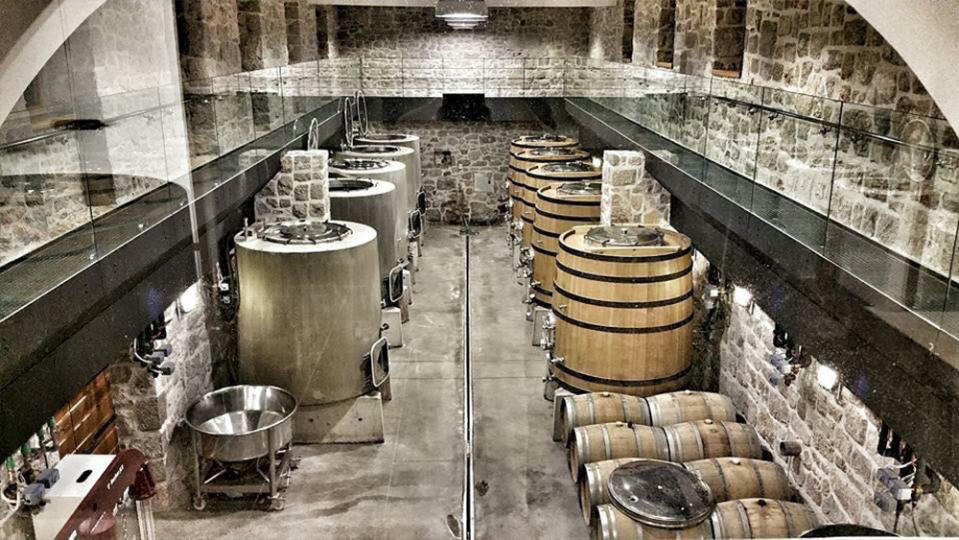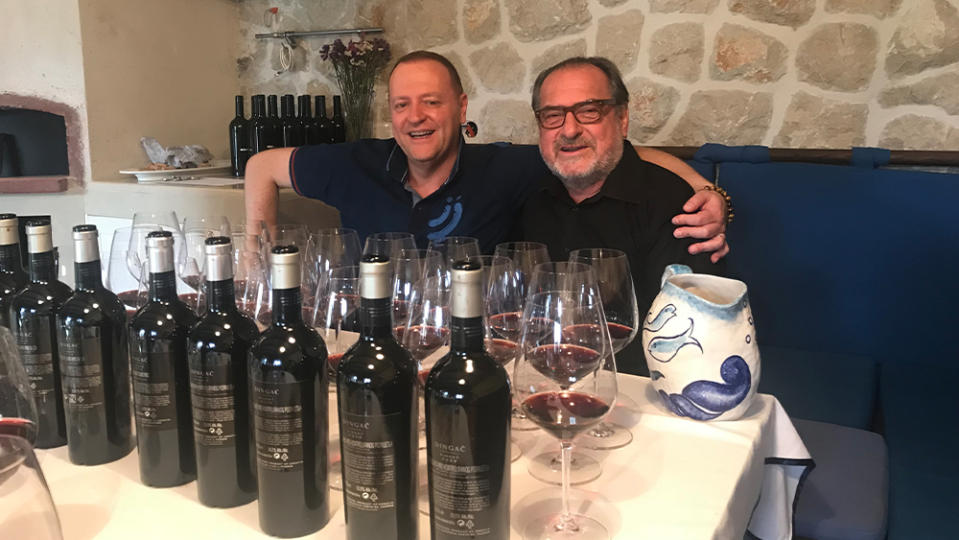Wine Blending, Explained: How Great Vintners Craft Their Vino

To truly appreciate a winemaker’s craft, it helps to better understand the art and science of blending. While we often think of blends as being made with multiple varieties such as Cabernet Sauvignon, Merlot and Cabernet Franc, there are many examples of single variety wines that are blended from different regions, vineyards, plots or barrels. Some blends styles are strictly regulated by regional wine authorities while others are made based on producer and enologist preference. Winemakers blend their wines for a variety of reasons, but it all comes down to the desire to release the best wine possible with the ingredients at hand. We spoke to top winemakers around the world about how they approach blending.
Although many Old World wine regions such as Bordeaux, Rioja or Chianti allow single varietal bottlings, the majority of the wines from these regions are made with a combination of grapes. Blending allows the best qualities of each variety to shine through. For example, Merlot’s tannins are significantly softer than Cabernet Sauvignon’s, so by adding some Merlot to Cabernet Sauvignon the lighter weight tannins will aid in the wine’s early drinkability. Conversely, Petit Verdot possesses heavy tannins, but it is generally utilized in small amounts to enhance color, body and floral aromas.
More from Robb Report
The 11 Best Wine Books Every Oenophile Needs in Their Library
How Restaurants Finally Learned to Pair Wine With Vegetarian Food
Château Lafite Rothschild Debuts Its First New Wine Label in More Than a Century
While winemakers in the New World are free to blend as they see fit, many of the classic Old World regions have strict requirements about the grapes that may be used in wine from the appellation. These include wines of Bordeaux and Rioja, both red and white, as well as Chianti, Tokaj, Sauternes, Madeira, Champagne and Rhône Valley appellations such as Côtes du Rhône, Hermitage, Côte Rôtie, Gigondas and Châteauneuf-du-Pape. Many fortified Port wines from Portugal’s Douro Valley are “field blends,” which means that vines bearing different varieties are grown, harvested and fermented together.
On the Spanish side of the Douro River, in Ribera del Duero, winemaking at Vivaltus is performed by Montxo Martínez alongside Jean-Claude Berrouet, who made 40 vintages of Petrus before his son Olivier took over at the storied Bordeaux château. Vivaltus 2017 is made with 96 percent Tempranillo, three percent Cabernet Sauvignon and one percent Merlot. More importantly, as Marcos Yllera, the winery’s owner explained, “In Vivaltus we use grapes from four main areas in Ribera del Duero . . . all with a multitude of different terroirs.” Ylleras further expounded, “The magic of Vivaltus is the magic hand and nose of Jean Claude Berrouet and his son Jeff . . . After all the vinification process guided by Berrouet and after the malolactic fermentation in stainless steel vats, our team joins Jean-Claude and Jeff to make the assemblage using different proportions of the different terroirs that have been vinified separately. During this blend, he decides which quantity of each different terroir is going to be Vivaltus or La Fleur Vivaltus, the second wine.”

Axel Heinz, the winemaker and estate director at Ornellaia in Bolgheri, Italy, works on several wines there, including Masseto, Ornellaia, and Le Serre Nuove dell’Ornellaia, considered the winery’s “second” bottling. Asked about what the different varieties contribute to the 2020 vintage of Le Serre Nuove, Heinz told Robb Report, “Merlot is at the heart of the blend. It brings a soft, fleshy and engaging texture and its proverbial generous fruitiness. Cabernet Sauvignon and Cabernet Franc, on the other hand, bring a touch of firmness to maintain focus and freshness, the latter in particular will add its spicy aromatic complexity. The last grape, Petit Verdot, brings weight, power and tannins to the blend, but has to be used very carefully, to not add too much rusticity and tannins.”
Napa Valley is well known for its Cabernet Sauvignons and red blends. Kristy Melton, winemaker at Freemark Abbey in Saint Helena, talked to Robb Report aboutFreemark Abbey 2018 Josephine Red Wine, which is made in honor of the winery’s founder, Josephine Tychson. Melton stated, “We craft this wine as a rich, complex, elegant and intriguing wine from St. Helena. A base of Cabernet yields dark fruit notes of black cherry and black raspberry with well-structured tannins. Merlot contributes elements of plum, vanilla and supple textures, while the Cabernet Franc and Malbec add exotic baking spice notes. The resulting blend is creamy, brooding and richly textured, making it great with food or simply lovely on its own.”
Blending single variety wines offers different challenges than making multi-varietal blends; for example, in a year in which one variety does not fully ripen, other grapes can be added to create a finished wine that does not highlight vineyard flaws. With a single grape such as Pinot Noir, many winemakers depend on different terroir, or what Erik Kramer, winemaker at WillaKenzie Estate in Oregon’s Willamette Valley, likes to call “neighborhoods.” Speaking about WillaKenzie Estate 2019 Clairiere Pinot Noir, Kramer told Robb Report, “WillaKenzie Estate has a very topographically diverse landscape and we produce several terroir-specific wines from different ‘neighborhoods’ on the property. Ultimately, the terroir in each of these neighborhoods drives each wine’s personality and expression. Beyond terroir, I’m also looking to craft very ‘texturally complete’ wines that are harmonious, balanced and compelling. That’s where blending plays a critical role and I believe it’s one of the most important parts of the winemaking process. We have over nine different clones of Pinot Noir planted across over 40 small parcels at the estate. Each of these clones and parcels bring something unique to the table.”
Ernest Tolj and his wife Ivana, owners of Saints Hills Winery near Dubrovnik, Croatia, were the first (and so far, only) proprietors in the country to enlist internationally renowned consultant Michel Rolland to work on their wines. Made with Plavac Mali, a deeply colored and highly flavorful grape indigenous to the Dalmatian coast, their Saints Hills 2019 Ernest Tolj is the current vintage of a wine that is only released in exceptional years; a portion of the proceeds from the wine goes to children’s charities. Asked how Rolland’s work with a single variety may differ from the blends he produces in Bordeaux, California and Argentina, Tolj stated, “I believe that the process is actually very similar, but the art is in the nose and in knowing at every phase of a wine’s life what will some actions lead to. Different varieties can blend well, but you can also get beautiful balance and layers you need from a single variety. It takes some work in the vineyard and some imagination in your cellar.”

Of course, white wines can be blended as well. At Australia’s Penfolds, chief winemaker Peter Gago has his hand in a wide range of wines that includes the flagship Syrah-based Grange as well as red blends and whites. Penfolds Yattarna 2020 Chardonnay is made with grapes from two different regions, with 68 percent from Tasmania and 32 percent from Adelaide Hills.
“Yattarna is our flagship Chardonnay. With a style like Yattarna, we make the best wine we can; there are no rules,” Gago says. “In some years it may require four regions. It can be a single region wine or multiple region wine. The style is about linearity and definition. We are looking to make cool climate, barrel-fermented Chardonnay that will go the distance.”
“Interestingly, Yattarna is an indigenous Australian word for ‘little by little’ or ‘gradually.’ The wine is also known as Bin 144, because there were 144 blending trials before the first vintage was created. As with Grange, we taste blind when doing the blending trials. It keeps us honest. With Grange, we don’t know any of the three V’s during blending: volume, variety or vineyard. We’re down to two V’s with Yattarna, volume and vineyard. It takes all the emotion out of the blend,” he continued.
Gago closed with words that apply to any winemaker regarding all of the decisions that go into crafting the beverage we love, “We just want to make the best wine we possibly can.”
Best of Robb Report
Why a Heritage Turkey Is the Best Thanksgiving Bird—and How to Get One
The 10 Best Wines to Pair With Steak, From Cabernet to Malbec
Sign up for Robb Report's Newsletter. For the latest news, follow us on Facebook, Twitter, and Instagram.

